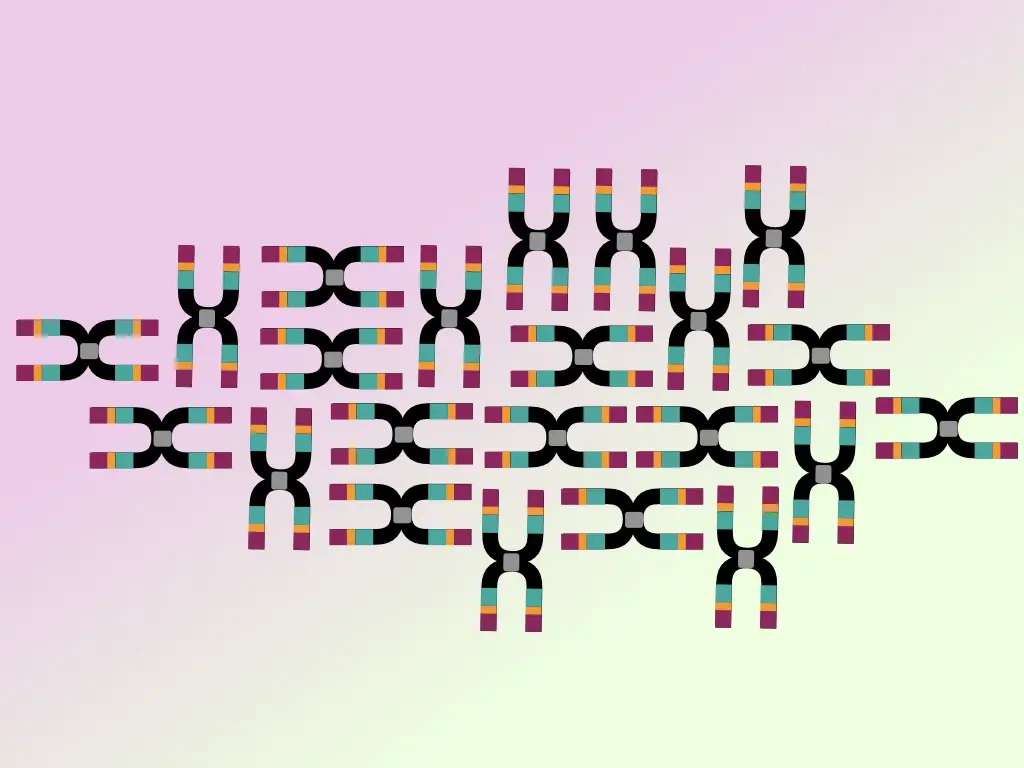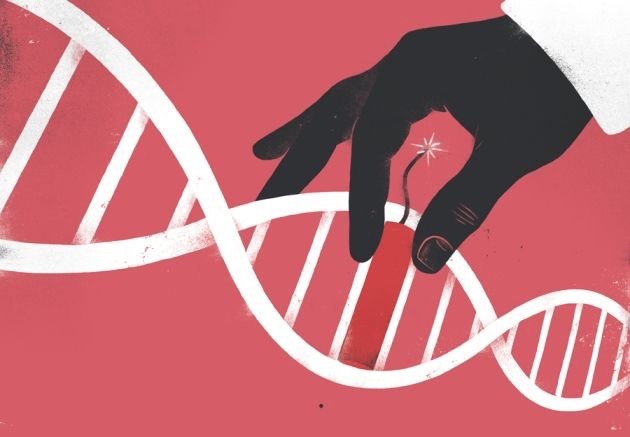“Y chromosome is a sex-chromosome and crucial for maleness. Explore the in-depth structural analysis (including important genes) and the function of the Y chromosome in the present article.”
Amazing Y Chromosome Facts:
- The Y chromosome evolved 300,000 years ago from autosomes.
- The Y chromosome is the smallest acrocentric chromosome
- The size of it is 57,227,415bp.
- It contains approximately 200 protein coding genes among which only 50 to 60 genes are functionally known.
- The centromere is located at the position of 10.4Mb.
- Only a single Y chromosome is present in Human males.
- The Y chromosome is not present in females.
Chromosomes are the complex network of DNA and proteins on which genes are located. Two types of human chromosomes are autosomes and sex chromosomes. 22 pairs of autosomes and a single pair of sex chromosomes are present in our genome.
Sex chromosomes X and Y have differences and a few similarities. Majorly, two XX chromosomes are present in a female while one X and one Y chromosome is present in a male. Genes located on the Y chromosome and Y-linked traits are largely associated with maleness, sex determination and differentiation.
Thus, the Y chromosome is significantly important for males on Earth. Comprehensive structural analysis of the Y chromosome provides insights into the genes and sequences located on it and how they inherit and determine these crucial male characteristics.
In this article, we will understand the structure of the Y chromosome, the genes located on it and their function. This article will definitely help those who are interested in infertility and related studies.
Stay tuned.
Disclaimer: Information provided here is collected from peer-reviewed resources and re-presented in an understandable language. All the sources are enlisted at the end of the article.
Abbreviations:
| SRY | Sex Determining Region on Y |
| AZF | Azoospermic Factor |
| TDF | Testis Determining Factor |
| PAR | Pseudoautosomal Region |
| MSY | Male-Specific region on the Y chromosome |
| SINES | Short Interspersed Elements |
| SOX | SRY-related HMG-box Genes |
| CTD | C Terminal Domain |
| NTD | N Terminal Domain |
Key Topics:
What is the Y Chromosome?
The Y chromosome is a type of human sex chromosome and is the smallest in this group. Hence, fewer genes it contains. In 1905, Nettie Stevens in collaboration with Bryn Mawr, identified the Y chromosome as a counterpart of the X chromosome.
However, it was only in 1923, that Wilson confirmed the role of the Y chromosome in male sex determination. Notedly, the master switch for male development– SRY gene was identified in 1989.
It’s a hemizygous mammalian chromosome that can only be inherited from a father to their male offspring and not female offspring. Meaning, that only a father can inherit the Y chromosome to his son.
It’s believed that the X and Y chromosomes are not independently present throughout evolution. They evolved later during the course of evolution to preserve reproductive phenotypes.
The Y chromosome independently appeared only before 3,00,000 years ago in the human genome.
Definition:
The Y chromosome is the smallest mammalian sex-determining chromosome that is responsible for sex determination, differentiation and development of secondary male characteristics.
Inheritance pattern:
Genes and chromosomes follow a distinct pattern of inheritance. Interestingly, the Y chromosome follows a unique pattern of inheritance, known as the Y-linked inheritance. Here genes on the Y chromosome only inherited from the father to their male child only, as we pointed out above.
Therefore, genes located on the Y chromosome are inherited by a male to their male offspring so are traits and diseases. Interestingly, the Y-linked Inheritance pattern is widely used in tracking the male lineages of a family.
Related article: Different Types of Inheritance Patterns.
Structure of a Y chromosome:
The Y chromosome is indeed ‘Y’ in shape. But it’s not its shape, from where the name ‘Y chromosome’ derived. Because the other chromosome of this group is the X chromosome, the name ‘Y chromosome’ is given to its mate.
Much like other chromosomes, it contains two chromosomal arms, a centromere and telomeres on both ends. Structurally, the Y chromosome is a smaller —acrocentric chromosome. It has a short ‘p’ arm and a long ‘q’ arm. The ‘p’ arm mostly contains genes and DNA sequences that are necessary for maleness, for example– the TDF and SRY. We will talk about it later.
A short Yp region is more euchromatin in nature and is transcriptionally active. Evidently, approximately 95% of the Y chromosomal region works dedicatedly for maleness and male phenotype development. The rest of the ~5% region is known as PAR- pseudoautosomal regions. Usually, the PAR sequences are transcriptionally inactive.
The centromere between the ‘p’ and ‘q’ arm helps in correct chromosomal segregation during the cell division. The centromere is also heterochromatin, a transcriptionally inactive region.
The approximate size of the Y chromosome is 59 million base pairs with 100 to 200 annotated genes. However, only 40 to 75 genes’ functions are known to us. Usually, the Y chromosome is almost the same in all other mammals.
For instance, the Y chromosome of our closest relative chimpanzee is only 30% different in terms of sequences, not size.
The telomeres, located on the extreme ends of the chromosomes, possess repetitive DNA sequences. Telomeres protect the chromosomal arms and maintain the structure of the Y chromosome. In general, telomeres are crucial for genomic (or we can say) chromosomal stability.
Male-Specific Region on the Y Chromosome:
The major portion of the Y chromosome is made up of the euchromatin and heterochromatin regions, collectively known as male-specific regions of Y. It roughly covers 95% of the p and q arms of the Y chromosome.
The euchromatin region has SRY, TDF and AZF-like genes while the heterochromatin region contains tandemly repeated SINE sequences throughout the MSY region. 5000 various repetitive sequences are present here.
Functionally, the present region possesses sequences and genes for maleness and male primary and secondary sexual characteristics. For instance—male gonadal development, spermatogenesis, and testicular development.
SRY Gene:
On the ‘p’ arm part of the MSY region, the SRY gene is located. The present gene is a candidate gene for maleness and is crucial for male gonadal development and differentiation.
The SRY gene is a Sex-determining Region on Y, located just near the pseudoautosomal region on the ‘p’ arm. It has a single functional exon, which encodes a protein having approximately 204 amino acids.
Structurally, the SRY gene is located within the specific region on the Y chromosome known as the Testis-determining region on Y- TDF. The TDF contains C-terminal and N-terminal domains. In between the CTD and NTD domains, a high mobility group DNA sequence region is present, known as the SOX.
Scientists believe that the SRY gene might have evolved from the SOX gene of the X chromosome. The SRY gene is one of the most important genes in the male sex determination and differentiation pathways, thus it is known as the ‘candidate gene’ in this process.
It’s also notable that the SRY gene alone can’t execute the present goal; various other autosomal genes are also involved in the present pathway. In vitro studies showed that loss of the SRY gene results in varied degrees of male infertility.
Other DNA sequences of the male-specific regions are the TDF region, the AZF region and the heterochromatin portion of the rest of the Y chromosome. Heterochromatins regulate gene expression.
A tine region excluding the MSY also has an important role. PAR is one such region.
PAR:
The PAR is known as a pseudoautosomal region located on the extreme ends of the Y chromosome. The PAR on the ‘p’ arm is approximately 2.5Mb in size while the PAR on the ‘q’ arm is approximately 1Mb in size.
The PAR region, a pseudoautosomal region, has genes homologous to the X chromosome’s PAR region. These two take part in the recombination during meiosis cell division. During male meiosis, PAR regions of X and Y combine and exchange genetic material. However, the rest of the Y regions remain conserved.
Unlike the autosomes, the PAR region is the only part that participates in the homologous recombination and maintains Y chromosome integrity, protects vital genes and supports maleness.
As the PAR region is less crucial for the actual development process, it recombines with the PAR of the X chromosome, and exchanges some genetic material but doesn’t interfere with other processes.
Abnormal PAR recombination causes serious implications such as sex reversal or partial sex reversal. The molecular mechanism behind PAR recombination is interesting. I will explain it in some other article.
Function of Y Chromosome:
The Y chromosomes and genes located on the Y chromosome play a vital role broadly in maleness, we can say. Here are a few particular functions of the Y chromosome.
It has a definite function in male sex determination and differentiation. The presence of the Y chromosome during the fetal stage or in the fertilized egg is a dominant marker for maleness.
The ‘intact’ Y chromosome with all the functional genes and sequences involved in sex differentiation, male reproductive organ development, male secondary sexual characteristics, spermatogenesis and testicular development.
The presence of the Y chromosome, thereby the SRY gene during the embryogenesis stage initiates testicular development. Note that other autosomal genes are also involved in this process.
Testis produces male sex hormones that help in the development of other sex organs and characteristics. SOX9, RSPO1, WNT, WT3 and SF1 are other genes that support this process.
Regions like the DAZ govern the process of spermatogenesis which is the process of sperm cell development, synthesis and maturation. It ensures intact male fertility.
One crucial function of the Y chromosome is to transfer the maleness genes from one to another generation. It inherits genes and preserves maleness on Earth.
Secondary characteristics like deep male voice, facial hair, and masculinity are also developed by the complex interaction of genes present on the Y chromosome.
As aforesaid, the Y chromosome also protects crucial genetic information present on its arms using PAR-mediated homologous recombination. Lastly, some Y-linked genes do have a significant role in other cellular processes.
Researchers used Y chromosomes as a marker to track the male lineage of a family. The STR repeats located on it are used in forensic studies and analysis.
List of Y linked genes:
| Gene | Full name |
| SRY | Sex determining region on Y |
| ZFY | Zinc finger protein, Y linked |
| PRKY | Protein kinase, Y linked |
| TDF | Testing determining region |
| AMGL | Amelogenin |
| AZF1 | Azoospermia factor 1 |
| AZF2 | Azoospermia factor 2 |
| DAZ | Deleted in azoospermia |
| UTY | Ubiquitously transcribed TPR gene on the Y chromosome |
| RBM | The RNA-binding motif on Y |
SRY:
- Full name: Sex-Determining Region Y.
- Location: Yq11.3.
- Length: 3.8Kb.
- Function: The SRY gene is a master gene for maleness and development of male secondary phenotypes.
ZFY:
- Full name: Zinc Finger Protein, Y-linked.
- Location: Yp11.2.
- Gene length: 47.2Kb.
- Function: ZFP is an important transcription factor and is involved in the regulation of gene expression. Studies demonstrate that it has an indirect connection with sex determination. Mutation in this gene also has a substantial connection with infertility-related problems.
PRKY:
- Full name: Protein kinase, Y linked.
- Location: Yp11.2.
- Length: 107.5 Kb in length.
- Function: The exact role of the PRKY is yet not well understood but it’s believed that it may have a definite role in cell signalling and regulation. Notedly, it’s an enzyme that performs protein phosphorylation.
TDF:
- Full name: Testing Determining Region
- Location: Yp11.2.
- Function: TDF is a region within the SRY gene and functions in the process of sex differentiation and determination.
DAZ1:
- Full name: Deleted in Azoospermia.
- Location: Yq11.223.
- Length: 69.7Kb.
- Function: DAZ1 is a part of the Azoospermia Factor and is involved in male spermatogenesis. It ensures male fertility and reproductive health.
UTY:
- Full name: Ubiquitously transcribed TPR gene on the Y chromosome or Ubiquitously Transcribed Tetratricopeptide Repeat Containing, Y-linked (UTY).
- Location: Yq11.22
- Length: 246 Kb.
- Function: The UTY gene encodes proteins having TPR repeats. It plays a vital role in protein-protein interaction, folding and assembly.
RBM:
- Full name: RNA Binding Motif on Y.
- Location: Yq11.22.
- Length: 24.8Kb.
- Function: RBM or RBMY gene encodes proteins having a role in RNA binding and post-transcriptional gene expression regulation.
AMGL:
- Full name: Amilogenin Y linked.
- Length: varied.
- Function: The Y-linked amelogenin is a pseudogene, however, its normal function is in the tooth enamel formation.
Summary:
| Name | Y Chromosome |
| Type | Sex-chromosome or allosomes |
| Size | 57,227,415bp |
| Number of Genes | 50 to 60 (known) |
| Important genes | SRY, TDF, AZF1, AZF2 and DAZ |
| Function | Development of maleness, testis, spermatogenesis, male secondary reproductive phenotypes, masculinity and other male-related phenotypes. |
| Cytological type | Acrocentric |
| Presence | Male |
Wrapping up:
In conclusion, the Y chromosome is so crucial for males. Without which, males do not exist on earth. However, majorly the Y chromosome has a role in male fertility and reproduction only.
Conventional karyotyping, PCR and DNA sequencing are several techniques using which the Y chromosome can be detected and tested. We will discuss these techniques in our next article.
The Y chromosome is an interesting entity in the Human Genome, I did research on it during my Ph.D. tenure and published a research and review paper. That I will discuss later.
Here is the link for the research paper that I have published: Cytogenetic and Microarray analysis of Eunuchs. I hope you like this article.
Sources:
- Quintana-Murci L, Fellous M. The Human Y Chromosome: The Biological Role of a “Functional Wasteland”. J Biomed Biotechnol. 2001;1(1):18-24. doi: 10.1155/S1110724301000080. PMID: 12488622; PMCID: PMC79676.
- Lasiene K, Vitkus A, Jurkeniene L, Sinkus A. Zmogaus Y chromosoma: struktūra ir biologinis vaidmuo [Human Y chromosome: structure and biological role]. Medicina (Kaunas). 2006;42(11):871-6. Lithuanian. PMID: 17172786.
- Gene Cards– Human Genes, Gene Database and Gene Search.
Subscribe to our weekly newsletter for the latest blogs, articles and updates, and never miss the latest product or an exclusive offer.


